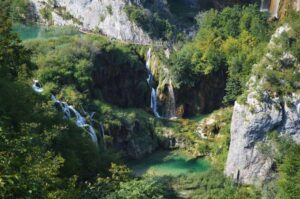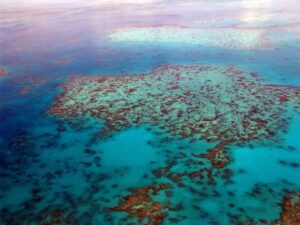Introduction
Imagine embarking on a journey that takes you to the most breathtaking and captivating destinations on Earth. In this article, we will delve into the top 5 most beautiful places to visit in the world, each offering a unique blend of awe-inspiring landscapes and cultural wonders.
From the surreal gem of Santorini in Greece to the tropical paradise of Bora Bora in French Polynesia, these beautiful Places in the World will leave you in awe of their natural splendour and cultural richness.
Discover the Top 5 Most Beautiful Places to Visit in the World
I. Santorini, Greece: A Surreal Gem in the Aegean Sea
Santorini, an enchanting island nestled in the Aegean Sea, boasts a beauty that seems almost otherworldly. With its captivating architecture and vibrant colours, this destination is a feast for the senses.
A. Enchanting Architecture and Vibrant Colors
The iconic blue-domed churches and whitewashed buildings create a picturesque scene against the azure backdrop. As the sun sets, the sky transforms into a canvas of vibrant hues, casting a spellbinding spectacle over the island.
B. Exploring the Ancient History and Rich Culture
Beyond its mesmerizing aesthetics, Santorini offers a glimpse into its ancient history and rich cultural heritage. Explore the ruins of Akrotiri, a prehistoric city buried under volcanic ash, and immerse yourself in the local cuisine and traditional festivities.
II. Bora Bora, French Polynesia: A Tropical Paradise
Bora Bora, located in French Polynesia, is a true tropical paradise renowned for its crystal-clear turquoise lagoons and pristine beaches. Here, you can bask in luxury and indulge in the wonders of nature.
A. Overwater Bungalows and Pristine Beaches
Picture yourself staying in an overwater bungalow, perched above the turquoise waters. Step onto the soft white sands and immerse yourself in the beauty of nature. Snorkel in the vibrant coral gardens and witness the kaleidoscope of marine life beneath the surface.
B. Discovering Polynesian Culture and Traditions
Bora Bora also offers an opportunity to immerse yourself in Polynesian culture and traditions. Witness traditional dances, enjoy the rhythmic beats of local music, and marvel at the intricate handicrafts.
Indulge in the flavours of the local cuisine and partake in traditional ceremonies that celebrate the island’s vibrant heritage.
III. Plitvice Lakes National Park, Croatia: Nature’s Masterpiece
Plitvice Lakes National Park, located in Croatia, is a true testament to the power and beauty of nature. This enchanting park is renowned for its interconnected lakes, cascading waterfalls, and untouched wilderness, creating a surreal and magical atmosphere.
A. A Symphony of Waterfalls and Lakes
As you enter the park, you’ll be greeted by a mesmerizing sight: a series of crystal-clear lakes that seem to blend seamlessly into one another. The vibrant colours of the lakes, ranging from emerald green to azure blue, are a result of the mineral content and the unique ecosystem of the area. Prepare to be captivated as you traverse the park’s wooden walkways, which allow you to get up close to the waterfalls and witness their majestic beauty.
B. Immersing in Outdoor Activities and Wildlife
Plitvice Lakes National Park offers a plethora of outdoor activities for nature enthusiasts. Explore the park’s numerous hiking trails, which wind through dense forests, across wooden bridges, and offer breathtaking viewpoints of the lakes and waterfalls. Boat rides are available, allowing you to navigate the lakes and witness the cascades from a different perspective.
Keep your eyes peeled for the park’s diverse wildlife. You might spot deer, bears, wolves, or rare bird species that call this pristine wilderness their home. The park’s ecological significance is evident, and conservation efforts ensure the preservation of its unique flora and fauna.
IV. Kyoto, Japan: Serenity Amidst Timeless Beauty
Kyoto, a city in Japan, is renowned for its serene beauty and timeless charm. With its abundance of tranquil temples, exquisite Zen gardens, and rich cultural heritage, Kyoto offers a glimpse into Japan’s traditional past.
A. Tranquil Temples and Zen Gardens
Kyoto is home to numerous temples and shrines, each exuding a sense of tranquillity and spirituality. Kinkaku-ji, also known as the Golden Pavilion, showcases stunning architecture and is surrounded by meticulously manicured gardens. Ryoan-ji Temple, famous for its rock garden, invites contemplation and serenity with its minimalist design.
Stroll through the mesmerizing Zen gardens, meticulously crafted landscapes that evoke harmony and peace. Take a moment to meditate and experience the Zen philosophy firsthand.
B. Experiencing Japanese Tradition and Cuisine
Immerse yourself in Japanese tradition by participating in tea ceremonies, where the art of tea preparation is elevated to spiritual practice. Encounter geisha culture in the historic district of Gion, where geishas can still be seen walking the streets in their elaborate traditional attire.
Kyoto is also a culinary delight, offering a wide array of traditional dishes. Indulge in kaiseki cuisine, a multi-course meal that showcases the freshest seasonal ingredients. Don’t miss the opportunity to witness traditional festivals, where the streets come alive with vibrant processions and lively performances.
V. The Great Barrier Reef, Australia: An Underwater Wonderland
The Great Barrier Reef, located off the coast of Australia, is an ecological marvel and a UNESCO World Heritage Site. Stretching over 2,300 kilometres (1,400 miles), it is the largest living structure on Earth and home to an astounding diversity of marine life.
A. Exploring the Colorful Coral Reefs and Marine Life
Diving or snorkelling in the Great Barrier Reef is a truly transformative experience. As you descend into the depths of the turquoise waters, you’ll be greeted by a kaleidoscope of colors. The coral reefs, comprised of intricate formations, display hues of vibrant reds, oranges, and blues. Swim alongside schools of tropical fish, including clownfish, parrotfish, and angelfish, as they weave through the coral gardens.
The reef is also a sanctuary for larger marine creatures. Keep an eye out for graceful sea turtles gliding through the water or the majestic presence of manta rays gracefully soaring through the depths. If you’re lucky, you may even spot dolphins playing in the distance or catch a glimpse of the elusive dugong, also known as the sea cow.
B. Conservation Efforts and Environmental Awareness
The Great Barrier Reef faces numerous challenges, including coral bleaching caused by rising water temperatures, pollution, and ocean acidification. However, extensive conservation efforts are being undertaken to protect and preserve this fragile ecosystem.
Various organizations, scientists, and governments collaborate to promote sustainable practices and raise awareness about the importance of preserving the reef. Initiatives include reducing pollution and runoff, implementing stricter fishing regulations, and promoting responsible tourism practices.
Visitors to the Great Barrier Reef can contribute to conservation efforts by choosing eco-friendly operators that prioritize reef health and educate visitors about the delicate balance of this unique ecosystem.
VI. Conclusion: Embracing the Unparalleled Beauty of the World
As we have explored the top 5 most beautiful places to visit in the world, it becomes apparent that beauty manifests in diverse forms. From the awe-inspiring landscapes of Santorini and Bora Bora to the natural wonders of Plitvice Lakes National Park, the cultural richness of Kyoto, and the underwater marvels of the Great Barrier Reef, each destination offers a unique tapestry of sights, experiences, and emotions.
While our list may be subjective, it is a testament to the astonishing beauty our planet has to offer. These places inspire us, connect us with nature, and remind us of the remarkable diversity that exists across the globe. Whether you seek tranquillity, adventure, cultural immersion, or simply the opportunity to marvel at the wonders of the natural world, these destinations will leave an indelible mark on your soul.
VII. FAQ: Answering Your Queries About Beautiful Places to Visit
Q1: Are these destinations suitable for families with children?
Yes, these destinations can be enjoyed by families. However, it is important to consider the specific needs and interests of your children and plan accordingly. Some destinations, such as Santorini and Kyoto, offer cultural and historical experiences that can be educational for children. Bora Bora and the Great Barrier Reef provide opportunities for water-based activities that children may find exciting.
Q2: Are these destinations accessible for individuals with mobility challenges?
Accessibility may vary depending on the destination. It’s advisable to check the specific facilities and accommodations available at each place. Many places have made efforts to improve accessibility, but it’s recommended to plan ahead and contact local authorities or tour operators to ensure a smooth experience.
Q3: What is the best time of year to visit these destinations?
The best time to visit these destinations varies depending on factors such as weather, crowd levels, and specific events. Here’s a closer look at the ideal times to visit each destination:
Santorini, Greece: The best time to visit Santorini is during the shoulder seasons of spring (April to June) and autumn (September to October). During these months, the weather is pleasant, and the island is less crowded compared to the peak summer season. The famous sunset views are particularly enchanting during these times.
Bora Bora, French Polynesia: Bora Bora enjoys a tropical climate with warm temperatures year-round. The dry season, from May to October, is considered the best time to visit, with lower humidity and less chance of rain. The shoulder seasons of April and November offer a good balance between favourable weather and fewer tourists.
Plitvice Lakes National Park, Croatia: The park is stunning throughout the year, but the best time to visit is during the spring and autumn months. In spring (April to June), the park comes alive with blooming flowers and lush greenery. Autumn (September to October) brings a beautiful display of colourful foliage. To avoid crowds, weekdays are recommended, especially during the peak summer season.
Kyoto, Japan: Kyoto experiences distinct seasons, each offering a unique charm. Spring (March to May) is famous for cherry blossom season when the city is adorned with delicate pink blooms. Autumn (September to November) showcases vibrant fall foliage, creating a picturesque setting. Both seasons are popular, so expect more tourists during these times.
The Great Barrier Reef, Australia: The best time to visit the Great Barrier Reef depends on your preferred activities. The dry season, from June to October, offers pleasant weather with less rainfall and clearer visibility for diving and snorkelling. However, the water temperatures are cooler during this time. The wet season, from November to May, has warmer water temperatures and is ideal for spotting migratory marine species. Be aware that cyclones can occur during the wet season, so it’s essential to stay updated on weather conditions.
It’s important to note that weather patterns and peak seasons can vary, so it’s recommended to research and plan your trip well in advance to ensure the best experience at these beautiful destinations.
Q4: Are these destinations budget-friendly for travellers?
The cost of visiting these destinations can vary depending on factors such as accommodation, transportation, dining options, and activities. Santorini and Bora Bora are known for their luxury offerings, so expenses tend to be higher in these destinations. However, there are budget-friendly options available, such as guesthouses or local eateries. Plitvice Lakes National Park and Kyoto offer a range of accommodation options to suit different budgets, and exploring the natural beauty of these places can be affordable or even free. The Great Barrier Reef can be more expensive due to activities like diving and snorkelling, but there are budget-friendly options for experiencing the reef, such as snorkelling tours or visiting accessible reef areas from the coast.
Q5: How can I ensure a sustainable and responsible visit to these destinations?
To ensure a sustainable and responsible visit, it’s important to be mindful of your environmental impact and respect the local culture and customs. Here are some tips:
Support eco-friendly accommodations and tour operators that prioritize sustainability and contribute to local communities.
Follow designated trails and paths in natural areas to minimize damage to the environment.
Respect wildlife and marine life by maintaining a safe distance and not feeding or touching them.
Dispose of waste properly and avoid single-use plastics. Carry a reusable water bottle and shopping bag.
Learn about and respect local customs and traditions. Dress modestly when visiting religious or culturally significant sites.
Conserve water and energy by being mindful of your usage in accommodations.
Support local businesses, artisans, and restaurants to contribute to the local economy.
By practising responsible tourism, you can help preserve the beauty and integrity of these destinations for future generations to enjoy.
Q6: Can I visit multiple destinations in one trip?
Yes, it is possible to visit multiple destinations in one trip, especially if they are geographically close or well-connected by transportation options. For example, Santorini and Plitvice Lakes National Park can be combined in a trip that explores different parts of Europe. Bora Bora and the Great Barrier Reef can be visited together as part of a trip to the South Pacific or Australia. Kyoto can be combined with other cities in Japan, such as Tokyo or Osaka, to create an immersive Japanese experience. Proper planning, including considering travel times, transportation options, and available itineraries, will help you make the most of your trip and explore multiple beautiful destinations.
Remember to allocate sufficient time to fully enjoy and appreciate each destination, and consider any visa requirements or travel restrictions that may apply when visiting multiple countries.









